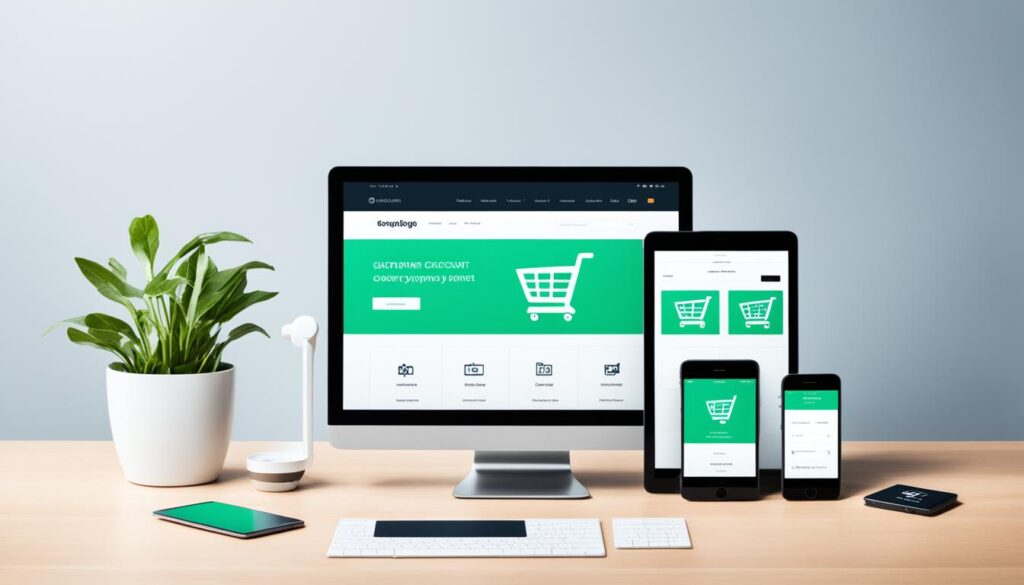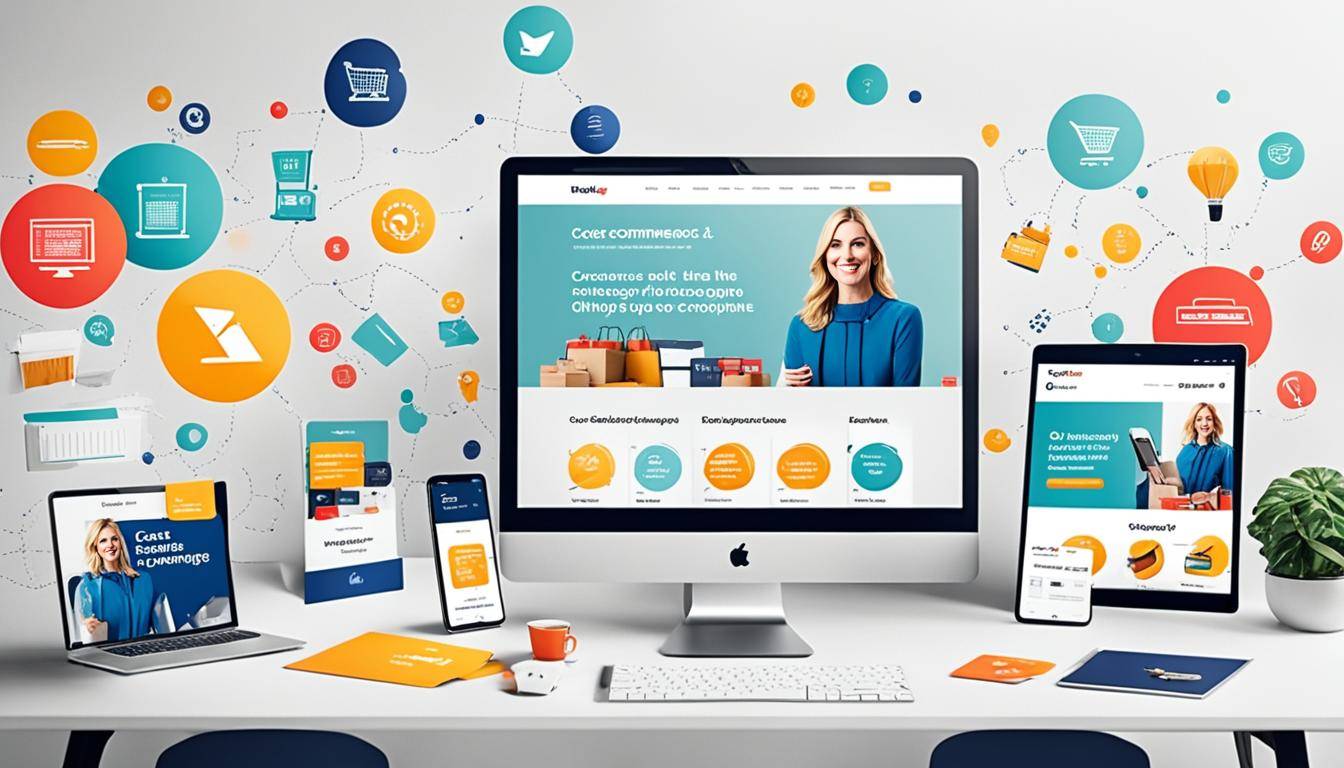Welcome to our guide on how to master E-commerce and Dropshipping in the UK. If you’re looking to start an online business, or take your existing business to the next level, you’re in the right place. The world of E-commerce and Dropshipping is rapidly growing and evolving, and it can be challenging to navigate. That’s why we’ve put together this comprehensive guide, complete with tips, strategies, and best practices to help you succeed in the UK market. Let’s get started!
Key Takeaways:
- E-commerce and Dropshipping are popular and growing sectors in the UK.
- Mastering E-commerce and Dropshipping requires an understanding of the fundamentals, choosing the right platform, sourcing quality products, leveraging Amazon FBA, and implementing effective strategies.
- There are several E-commerce platforms available, such as Shopify and WooCommerce, each with their pros and cons.
- Product sourcing is crucial for Dropshipping businesses, and finding reliable suppliers is key to success.
- Amazon FBA can simplify your order fulfillment process, boost sales, and expand your reach.
Understanding E-commerce and Dropshipping
Are you curious about E-commerce and Dropshipping? Here, we will explore the fundamentals of these online business models.
E-commerce
E-commerce refers to the buying and selling of goods or services over the internet. Unlike traditional retail, E-commerce allows businesses to reach a global audience and operate 24/7. With an E-commerce store, you can offer a personalized shopping experience to your customers, optimized for their preferences, by leveraging data collection and analysis. Also, E-commerce can be a cost-effective solution compared to traditional retail stores since you don’t need to pay for rent or the overhead associated with a physical store.
Dropshipping
Dropshipping is a method of E-commerce wherein the retailer doesn’t keep inventory in stock. Instead, they transfer customer orders and shipment details to the manufacturer, wholesaler, or another retailer, who then ships the goods directly to the customer. With this business model, you can sell products without worrying about managing inventory or fulfilling orders manually. Moreover, this can lower the costs of running an online business, initially.
Advantages and Challenges of Online Business
- E-commerce and Dropshipping offer more flexibility, scalability, and a lower barrier to entry compared to traditional retail.
- Online businesses can reach a global audience, operate 24/7, and leverage data collection and analysis to provide personalized shopping experiences.
- E-commerce can be a cost-effective solution compared to traditional retail stores since you don’t need to pay for rent or the overhead associated with a physical store.
- However, there are challenges, such as increased competition, a reliance on technology and internet infrastructure, the need to optimize website design, UX, and SEO, and the potential risks associated with payment processing and customer data storage.
- Nevertheless, with the right strategies, tools, and insights, you can build a successful online business, achieve your goals, and reach your potential as an entrepreneur.
“E-commerce and Dropshipping offer a cost-effective and scalable business model for entrepreneurs of all sizes, but mastering these requires dedication, knowledge, and a willingness to adapt to a rapidly changing digital landscape.”
Choosing the Right E-commerce Platform
When it comes to choosing the right E-commerce platform, it’s essential to consider your business’s needs carefully. Two of the most popular options on the market are Shopify and WooCommerce.
If you’re looking for an all-in-one platform that’s easy to use, Shopify might be the right choice for you. It offers a variety of customizable templates, an intuitive dashboard, and built-in features like payment processing and inventory management. Plus, it’s an excellent choice for beginners who are just starting with E-commerce.

“Shopify is a game-changer for my online store. I’m amazed by how quickly I can create and manage my site, process payments, and generate reports.” – Sarah Taylor, owner of Sarah’s Clothing
On the other hand, if you want more control over your website and are comfortable with a steeper learning curve, WooCommerce might be the better option. It’s a plugin for WordPress that gives you complete control over your site’s design and functionality. Plus, it offers a vast array of add-ons and extensions to help you scale your business as it grows.
| Shopify | WooCommerce | |
|---|---|---|
| Price | Starts at $29/month | Free, but additional costs for hosting and add-ons |
| Design | Customizable templates with drag-and-drop functionality | Complete control over site design with WordPress themes |
| Ease of Use | Intuitive dashboard and easy setup | Steep learning curve but plenty of online resources available |
| Features | Built-in payment processing, inventory management, and SEO optimization | Access to thousands of plugins and extensions for added functionality |
Ultimately, the choice between Shopify and WooCommerce comes down to your business’s unique needs and preferences. Consider factors like your budget, website design, desired features, and skill level when making your decision.
Key takeaways:
- Shopify and WooCommerce are two popular E-commerce platforms to consider
- Shopify is user-friendly and easy to set up, making it an ideal choice for beginners
- WooCommerce offers complete control over site design and functionality but requires more technical knowledge
- The choice between the two depends on your business’s specific needs and preferences
Mastering Product Sourcing for Dropshipping
One of the most crucial aspects of successful Dropshipping is product sourcing. Finding reliable suppliers and ensuring consistent product quality are key to running a profitable business. Here are some tips to help you master product sourcing for Dropshipping:
1. Research and Compare
Take the time to research potential suppliers thoroughly. Look for reviews and ratings from other customers to gauge their reliability. You can also compare prices and shipping times to find the best deal. Consider using platforms like AliExpress, SaleHoo, or Oberlo to connect with verified suppliers.
2. Build a Relationship
Building a relationship with your suppliers can help ensure consistent quality and better pricing. Regular communication and feedback can help build trust and establish a long-term partnership. Remember that suppliers are often more willing to negotiate prices and terms with reliable and trustworthy partners.
3. Test the Products
Before selling any product, be sure to test it yourself. This will help you ensure that the product is of good quality and that your customers will be satisfied. You can also use tools like Jungle Scout to analyze product demand and profitability.
“Product sourcing is crucial when it comes to running a successful Dropshipping business.”
4. Consider Product Liability
As a Dropshipper, you are responsible for any product defects or issues that arise. Consider purchasing liability insurance to protect yourself from any potential lawsuits or damages. You can also work with suppliers who offer product warranties or guarantees.
5. Stay Organized
Organize your product information, supplier contacts, and shipping details to ensure smooth order fulfillment and customer satisfaction. You can use tools like Google Sheets or Trello to keep track of your inventory and orders. Consider setting up automatic order management systems to streamline the process and save time.
By following these tips, you can master product sourcing for Dropshipping and ensure the success of your online business. Remember, quality products and reliable suppliers are the foundation of a thriving E-commerce business.
Unlocking the Power of Amazon FBA
When it comes to improving your online business, the right tools can make all the difference. One such tool is Amazon FBA, or Fulfillment by Amazon. This service allows you to store your products in Amazon’s fulfillment centers, where they handle the packing, shipping, and customer service for orders placed on Amazon.com.
By leveraging Amazon FBA, you can simplify your order fulfillment process and focus on other aspects of your online business. This service also makes it easier for your customers to receive their orders quickly and efficiently, which can help boost your sales and customer base.
With Amazon FBA, you can also expand your reach by taking advantage of Amazon’s global fulfillment network. You can sell your products to customers in other countries with ease, without having to worry about international shipping and customs.
So, how does Amazon FBA work? First, you need to create an Amazon seller account and list your products on the Amazon website. Then, you can choose to enroll your products in the Amazon FBA program.
Once enrolled, you’ll need to send your products to an Amazon fulfillment center. Amazon will store your products, and when a customer places an order, Amazon will handle the packing and shipping of the product to the customer. Amazon will also handle any returns or customer service inquiries related to the order.
Overall, Amazon FBA can be a valuable E-commerce solution, particularly for those engaged in Dropshipping. This tool has the potential to transform your online business by simplifying your fulfillment process, boosting your sales, and expanding your reach.

Amazon FBA Advantages:
- Simplified order fulfillment process
- Fast and efficient delivery to customers
- Global reach and expanded customer base
- Cost savings due to bulk fulfilment and shipping
Amazon FBA Disadvantages:
- Storage fees for inventory at Amazon’s fulfillment centers
- Difficulty in maintaining control over the fulfillment process
- Difficulty in offering a personal touch to customer service
- Higher fees for multi-channel fulfilment
Tips for Running a Successful Online Store
Running an online store can be challenging, but with the right strategies, you can increase your chances of success. Here are some expert tips to help you:
Optimize Your Website
Make sure your website is user-friendly, mobile-responsive, and easy to navigate. Use high-quality images, clear product descriptions, and engaging calls-to-action to entice visitors to make a purchase. Utilize SEO best practices to improve your search engine rankings and drive more traffic to your site.
Provide Excellent Customer Service
Make it easy for customers to contact you and respond to their inquiries promptly and professionally. Offer free shipping, easy returns, and hassle-free refunds to create a positive shopping experience for your customers.
Use Email Marketing
Grow your email list and send regular newsletters, special offers, and personalized recommendations to your subscribers. Use email marketing to nurture your relationships with your customers and encourage repeat business.
Partner with Influencers
Collaborate with social media influencers in your niche to promote your products and drive more traffic to your website. Choose influencers who resonate with your brand, have a sizeable following, and can create high-quality content.
Track Your Metrics
Use analytics tools to track your website traffic, conversion rates, and customer data. Use this data to identify areas for improvement, measure the effectiveness of your marketing campaigns, and make data-driven decisions to grow your business.
Remember, success in e-commerce takes time and effort. Continuously learn and apply new strategies to stay ahead of the competition and create a thriving online business.
Conclusion
Embarking on an E-commerce and Dropshipping journey in the UK can be a fruitful venture if done right. By understanding the basics, selecting the right platform, finding trustworthy product sources, utilizing Amazon FBA, and implementing successful strategies, you can create a profitable online presence. Remember to optimize your website, driving traffic, and securing conversions. It’s a journey that requires patience, persistence, and innovation. The UK market is ready to be conquered. Will you be the one to take the leap?
FAQ
What is E-commerce?
E-commerce, short for electronic commerce, refers to the buying and selling of goods and services online. It involves online transactions and the transfer of money and data through secure payment systems.
What is Dropshipping?
Dropshipping is a business model where the retailer does not keep any inventory. Instead, when a customer places an order, the retailer purchases the product from a third-party supplier who then ships it directly to the customer. This eliminates the need for storing and managing inventory.
How is E-commerce different from traditional retail?
Unlike traditional retail, E-commerce allows customers to shop anytime and anywhere using their electronic devices. E-commerce offers convenience, a wider range of products, and the ability to compare prices easily. It also eliminates the need for physical store space.
What are the advantages of running an online business?
Running an online business offers several advantages, such as low startup costs, the ability to reach a global audience, flexibility in working hours, and the potential for scalability. It also provides the opportunity to leverage technology and data analytics to optimize sales and marketing strategies.
Which E-commerce platform is right for my business?
There are several E-commerce platforms available, including Shopify and WooCommerce. Shopify is known for its user-friendly interface and robust features, while WooCommerce is a plugin for WordPress that offers more flexibility and customization options. Consider your business needs, budget, and technical expertise when choosing a platform.
How do I find reliable suppliers for Dropshipping?
To find reliable suppliers for Dropshipping, you can use online directories and marketplaces, attend trade shows, reach out to manufacturers directly, or work with dropshipping-specific platforms like AliExpress. It’s important to research and vet suppliers to ensure they offer quality products, reliable shipping, and good customer service.
What is Amazon FBA and how does it work?
Amazon FBA, or Fulfillment by Amazon, is a service offered by Amazon where sellers can store their products in Amazon’s fulfillment centers. Amazon takes care of the storage, packaging, and shipping of the products when an order is placed. This service simplifies order fulfillment for sellers and allows them to leverage Amazon’s vast customer base.
What are some tips for running a successful online store?
To run a successful online store, focus on creating a user-friendly website with clear navigation and attractive product images. Optimize your site for search engines, engage with customers through social media and email marketing, offer excellent customer service, and regularly analyze and optimize your sales and marketing strategies based on data.







